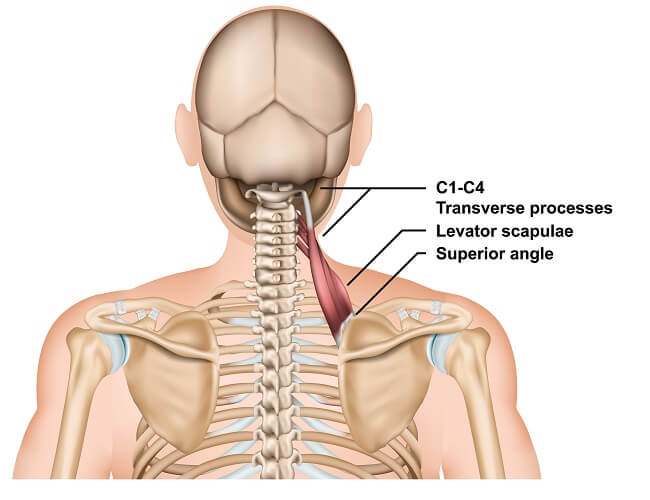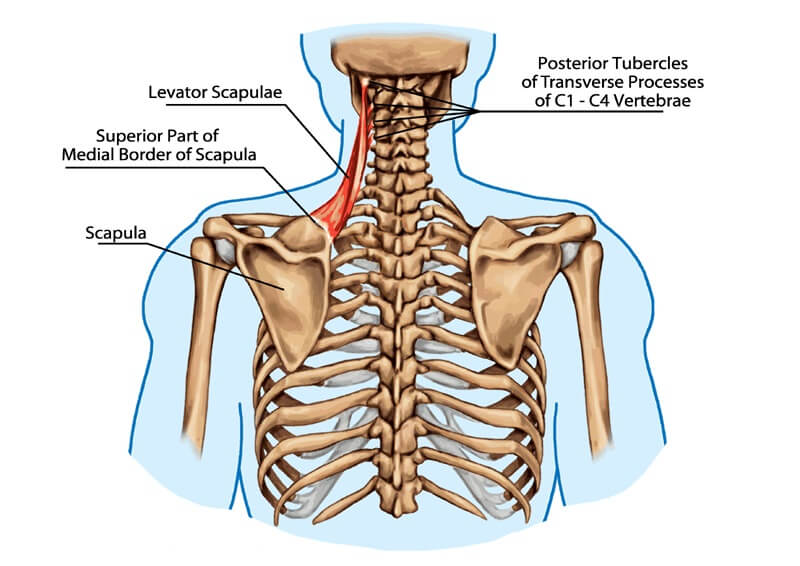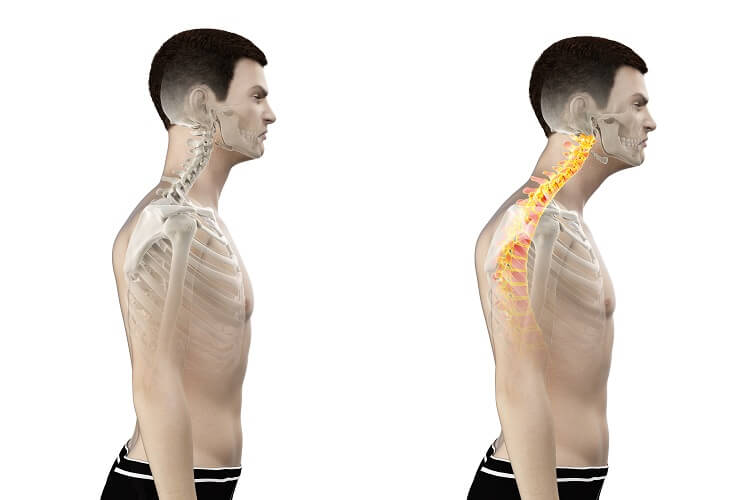Definition
The levator scapulae muscle (sometimes called the lev scap) is a strap-like muscle found on either side of the back of the neck. When viewed from the posterior, the muscles are masked by the trapezius muscle in the upper back.
There are two of these muscles, one on the left, and one on the right side of the back of the neck. From their site of origin, they descend towards the shoulder and upper back.
Functionally, the primary role of the levator scapulae muscles is to elevate and rotate the shoulders. Therefore, tightness in the levator scapulae muscles is commonly associated with back, neck, and shoulder pain and dysfunction.

Anatomy of the Levator Scapulae
Each of the levator scapulae muscles originates from the posterior tubercles of the transverse processes of C1, C2, C3, C4. In more simple terms, the muscles arise from the back (posterior) side of the bony projections found in the first four cerebral vertebrae.
The muscle inserts into the superior part of the medial border of the scapula from the superior angle to the smooth triangular space. To put it more simply, it inserts towards the top of the broad, inner side of each shoulder blade.
The levator scapulae muscle is innervated by two nerve branches: the nerves of the cervical plexus (C3-C4) as well as the dorsal scapular nerve. The dorsal scapula arises from the root of C5 of the brachial plexus. The dorsal scapular nerve innervates three muscles: the levator scapulae, the rhomboid minor, and the rhomboid major.
Anatomic Variation
The number of attachments present in the levator scapulae is variable between individuals. In fact, researchers have demonstrated that there are several potential accessory attachment sites to which the levator scapulae can insert. These include the upper ribs and their associated muscles and other muscles in the upper back, such as the serratus posterior superior. Importantly, these variations are thought to impact the function of the muscles and could also contribute to potential pain and inflammation.

Function of the Levator Scapulae
As the name of the muscle suggests, the actions of the levator scapulae are mainly on the movement of the shoulders and the shoulder blades (the scapula). When the levator scapulae muscle contracts, the act of scapular elevation (i.e. shoulder raising) is performed. You can easily demonstrate this yourself by shrugging your shoulders.
The levator scapulae muscle also controls the downward rotation of the scapula. Downward rotation is the movement where the shoulder blades are brought downward. For example, stand with your arms by your side, and then, keeping both arms straight, raise them by your sides until they meet in the middle above you. Then, reverse the movement, returning your arms to your sides.
The action of moving your arms back to their resting position at your sides depends on downward rotation; raising them up requires upward rotation.
Finally, the levator scapulae muscle performs the adduction of the scapula. That is, it brings the shoulder blades towards the middle of the body. You can try this by pushing your shoulders towards one another through your back. As a consequence of this movement, your shoulder blades will come together and your chest wil stick out.
The levator scapulae muscles do not perform these actions alone. They work with the minor and major rhomboids and the trapezius, as well as the pectoralis minor, to carry out these functions.
Levator Scapulae-Associated Pain
Pain in the levator scapulae is one of the most common skeletal muscle complaints that people bring to health care professionals. This is because the levator scapulae muscles can get very tight and inflamed if they are overworked. This happens when the shoulders are frequently elevated, and especially when individuals are slumped over.
Therefore, pain in this muscle is common in people who work at computers (especially if the desk and chair are not ergonomically designed). It is also common in people with a ‘head forward’ posture (sometimes called upper crossed syndrome), in people who regularly carry a heavy bag on one shoulder, and in individuals who perform activities with repetitive arm movements, such as swimmers, tennis players, and shot putters.

This type of pain is felt directly at the location of the levator scapulae, as well as in the structures surrounding the neck, shoulders, shoulder blades, and elsewhere in the upper back.
Additionally, pain and tightness of this muscle can cause impaired movement of the neck and shoulders. It can even cause pain and dysfunction in the cervical structures that could lead to cervicogenic headaches.
Interestingly, much of the pain associated with the levator scapulae is thought to be a result of anatomical variation that alters the insertion point of the muscle.
Chronic inflammation and pain associated with the levator scapulae even has its own name – levator scapulae syndrome. This term is rarely used in modern medical literature and is mostly used historically.
Myofascial Pain Syndrome
Myofascial pain is associated with pain in the pressure points (termed trigger points or knots) of the muscles. These trigger points are tight, hypersensitive regions that usually develop as a result of overuse of a particular muscle or group of muscles. For example, as a result of repetitive contraction of muscles during work or sport and exercise activities. Unsurprisingly, the levator scapulae muscle is one of the most common sites of myofascial trigger points.
Myofascial pain becomes a syndrome when there are many of these pressure points that worsen over time. However, the pathology of this disorder is controversial. The mechanisms through which this pain develops are unclear. It has also been suggested that it is actually a subtype of fibromyalgia.
Treatment
Usually, irritation, inflammation, and tightness of the levator scapulae muscle are treated with a combination of physical therapy and massage. Reducing the activity of the muscle can also help to prevent its overuse. Additionally, stretching exercises can be performed to relax the muscle and prevent it from becoming taut.
Finally, in more extreme cases in which these approaches are not successful, the patient might receive local steroid injections directly into the trigger points.
Quiz
